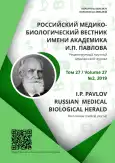Computer model for identification of groups of risk for malignant neoplasms of fe-male sex sphere using questionnaire
- 作者: Malashenkо V.N.1, Ershov A.M.1, Ershova Y.V.1
-
隶属关系:
- Yaroslavl State Medical University
- 期: 卷 27, 编号 2 (2019)
- 页面: 219-226
- 栏目: Original study
- URL: https://bakhtiniada.ru/pavlovj/article/view/14546
- DOI: https://doi.org/10.23888/PAVLOVJ2019272219-226
- ID: 14546
如何引用文章
详细
Aim. To identify predictors of malignant neoplasms (MN) of female sex sphere, to evaluate their sensitivity and specificity, to calculate prognostic coefficient (PC) and to create a computer program on its basis for automated processing of questionnaire data for arrangement of groups of risk for regular medical check-ups through the Internet (without participation of a physician) or on computers of women’s health clinics.
Materials and Methods. The work was performed in two steps. The 1st step was an open questioning survey of 226 women, divided into 2 groups: the 1st group included women with MN of the sex sphere (n=125); the 2nd group included conventionally healthy women. The questionnaire included 82 positions: 19 open questions and 63 questions with a choice of an answer. The second stage consisted in a «blind» questioning of 120 women who visited a women’s health clinic. The questionnaire included 18 earlier identified predictors. A multifactor model was developed on the basis of questionnaire data and also using the material of medical histories and of histological examinations.
Results. Using ROC-analysis of the questionnaire data, 18 significant predictors of MN of female sex sphere were identified. On their basis a formula was derived for calculation of PC for the risk of development of MN of female sex sphere with 72.8% sensitivity and 95% specificity, which was used for creation of a computer model for automated processing of questionnaire data with the aim of identification of groups of risks and for medical check-ups without participation of physicians through Internet sites of hospitals. Then, in result of closed questioning of women (n=120) by 18 predictors, 70 women got into a group of risk, in 47 of them (67%) MN of sex sphere were identified, 50 fell into a group of conventionally healthy women, of them 45 (90%) were healthy, and 5 (10%) had MN.
Conclusions. 1) Multifactor statistical ROC-analysis of 82 questions and answers permitted to identify 18 predictors of MN of female sex sphere which can be used to scientifically substantiate identification of groups of risk for organization of regular prophylactic measures. 2) The conducted work permitted to create a computer program for automated processing of questionnaires for formation of groups of risk and for regular medical check-ups. We believe that introduction of questionnaire screening through the Internet with subsequent computer processing of the results without participation of physicians with permit to increase the coverage of women’s population of the Russian Federation with prophylactic measures against MN of the female sex sphere and to provide more time for receipt of primary patients, to simplify the work for creation of data base, and to increase the oncological alertness of women’s population.
作者简介
Viktor Malashenkо
Yaroslavl State Medical University
Email: vestnik@rzgmu.ru
SPIN 代码: 4229-9481
MD, PhD, Professor, Head of the Department of Oncology with Hematology
俄罗斯联邦, YaroslavlAlexey Ershov
Yaroslavl State Medical University
编辑信件的主要联系方式.
Email: alesha95951@mail.ru
ORCID iD: 0000-0002-4166-479X
SPIN 代码: 1988-0031
Resident
俄罗斯联邦, YaroslavlYulia Ershova
Yaroslavl State Medical University
Email: vestnik@rzgmu.ru
ORCID iD: 0000-0003-4328-9150
SPIN 代码: 9484-9860
MD, PhD, Associate Professor of the Department of Obstetrics and Gynecology
俄罗斯联邦, Yaroslavl参考
- Collection of Medical Statistics. Yaroslavl; 2018. (In Russ).
- Ershov AM, Malashenko VN, Ershova YuV. A method for predicting malignant tumors of the female genital through questionnaires. Research and Practice in Medicine. 2018;5(S1):32-3. (In Russ). doi: 10.17709/2409-2231-2018-5-S1
- Organization of the clinical examination and preventive medical examinations of the adult population. Guidelines. Moscow; 2013. (In Russ).
- Nikoghosyan SO, Kuznetsov VV. Modern Diagnosis of Ovarian Cancer. Russian Journal of Oncology. 2013;(5):52-6. (In Russ).
- Kaprin AD, Starinsky VV, Petrova GV. The state of oncological assistance to the population of Russia in 2014. Moscow; 2015. (In Russ).
- Goryaeva AE, Petrov YuA. Cervical cancer scree-ning. International Journal of Applied and Fundamental Research. 2018;(4):171-5. (In Russ).
- Meshkov AV, Vaziev IK, Gerasimov LI, et al. Questionnaire screening is a method of primary cancer prevention (for example, carcinogenic production). Modern Problems of Science and Education. 2015;(2-1). Available at: https://science-education.ru/ru/article/view?id=18771. Accessed: 2019 February 15. (In Russ).
- Vilansky MP, Uglev NN. Screening in mass preventive examinations: automated system. Moscow; 1987. (In Russ).
- Vesco KK, Whitlock EP, Eder M, et al. Screening for cervical cancer: a systematic evidence review for the U.S. Preventive Services Task Force. Rockville, MD; 2011.
- Frederiksen ME, Lynge E, Rebolj M. What women want. Women’s preferences for the management of low-grade abnormal cervical screening tests: a systematic review. An International Journal of Obstetrics and Gynaecology. 2012;119(1):7-19.
- Malashenko VN, Ershov AM, Ershova YuV. A method for predicting the risk of developing malignant tumors of the female genital sphere. Patent RUS for invention №2687780. (In Russ).
补充文件







